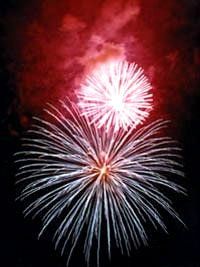Beginner Photo Tips
Beginner Camera Choice
Choosing the right camera can be difficult. We provide trained, knowledgeable people that help you decide which camera is right for you. This is a short guide to help you make the right camera choice.
Film Cameras
| Advantage | Disadvantage | Comments |
|---|---|---|
| Lower cost. More bells and whistles. | Can???t view images immediately. | Get a great camera with all the features you want for ?? the cost of a digital |
| Easy to use. | Airport security scanners may damage film. | Take extra time traveling with film. Hand carry it through security. |
| Uses Standard batteries that are available everywhere | If camera malfunctions you may not be aware until your film is developed. | Get used to how your camera operates and sounds. Listen to it! |
| 35mm film produces a full frame 4x6 standard print | When your film is developed, you pay for all the pictures, even the ones you don???t want. | Standard 4x6 printing does not apply to full frame digital cameras. |
Digital Cameras
| Advantage | Disadvantage | Comments |
|---|---|---|
| Can be used for a multitude of applications | Takes time and practice to understand most effective use. | Don???t buy one if you don???t want to learn something new. |
| Preview and edit images immediately | Cost is higher than 35mm with same features | For a good quality digital camera, plan on spending between $400-$1000 |
| Digital media can be used over and over | Cost of digital media is high on the front end. | Buy the right media for your camera Ask us about the write speed of media. |
| With good planning, you can travel the world with out having to buy more digital media. | Plan on a good way to archive your images. For safety. | We can archive digital files for you. Don???t leave them on your hard drive. |
Composition for the Beginner
Good composition has four main elements. The subject matter and its placement, the background, the lines that direct the viewer???s eye, and the lighting. These elements equally effect how a photograph is viewed.
Before you take a photograph ask yourself, why you are taking this picture, and what you are trying to achieve. Don???t be afraid to take as many different angles as time will allow. Place your subject in different areas in the photo. Try changing the angle to find what you think is the best and/or most dramatic lighting. As you look through your camera, look at the entire scene. So many photographers concentrate solely on the subject. Look all around the subject. Are there any elements of the background or lighting that will take your eye away from the subject when the picture is printed?

The best photographs are usually the most simple. The best way to create a simple photograph is to follow these simple steps:
- Keep the background as simple and as uncluttered as possible.
- Use the available lighting to create a dramatic effect on your subject.
- Fill the frame with the subject and move as close as possible.
- Move around your subject. Take several shots with different lighting and positioning.
- Are there lines in the background that you can use to lead the viewer???s eye to the subject?
Have fun with photography! Join a camera club! There is no better way to learn than from people who love the art!
Photographing People
Taking better photographs of People.
People are the most photographed subjects in our society and they can be the most interesting as well. A good people photograph tells the viewer something about that person by the way emotion and character connects with the viewer. Here are six simple tips to make your people pictures more effective.
- Fill the frame with the person???s face. If you need a full body shot of the person, turn your camera vertical in order to make the subject as large as possible in the photo.
- Take several pictures at different angles, and with different lighting. If the sun is bright, use a fill flash to fill in the shadows in the eye sockets and to kill the shadows from the hair, glasses, nose or ears.
- Put your subject in a bright area while finding a darker more simple background. This will help have the subject ???pop out??? in the photo by providing contrast.
- Use telephoto lenses when shooting portraits. Wide-angle lenses tend to distort the shape of your subject???s face. The further you stand away from your subject, the more comfortable your subject will be.
- Set up your equipment before you start shooting. Make sure that you are ready to go before hand. You will have a better opportunity of catching a more natural expression.
- Relax everyone you photograph before you start shooting, and keep him or her engaged while you are shooting. When they are paying attention to what you are doing, you will get better results.
Be sensitive to those that you photograph. If you sense tension or uneasiness, try relaxing them by telling a joke or by complimenting their appearance.
Red Eye Tip
How To Reduce Red-eye


Red-eye is caused by the flash bouncing light off the retina of the eye and recording on the film. The same problem comes up with your pets as green-eye or blue-eye.
With a little preperation you can reduce red-eye with these easy to use tips.
When possible, and for best results, combine these tips to eliminate red eye altogether.
| Action | Comments |
|---|---|
| Red-eye flash mode | Small point and shoot cameras have this mode. It flashes one or more times before the shutter to constrict the iris of the eye as much as possible. Be sure to tell every one what to expect or they will look away as soon as they see the first flash. |
| External Flash | This increases the angle of the flash to eye. Red-eye rarely occurs with the use of an external flash. |
| Get Closer | This will widen the angle of the flash from the eye. Keep in mind that when photographing a group to use other methods. |
| Have person look away slightly | Ask your subjects to look slightly to the right or left. |
| Increase the amount of ambient light | If there is time to set up. Brighten the room as much as possible. This will help constrict the iris. The more light the better when indoors. |
There are special pens available for sale to correct the red-eye effect on photographs. Be very careful when using one of these pens. If the ink is smudged or not applied properly, it will not come off.
Due to the amount of time it takes to correct red-eye, it cannot be corrected in normal production printing. If you have a print that you would like fixed, bring it in and let us save you time and frustration. Our finished product will look perfect!
Travel Photography Check List
This is a list of essential photo supplies to bring with you on your next trip. Use this list as an inventory of what you will bring with you. It will come in handy when you come home. Use this checklist to help you remember everything you brought with you.
| Item | Quantity | Outbound | Return |
|---|---|---|---|
| Camera | |||
| Back up Camera | |||
| Batteries (How many sets?) | |||
| Camera Bag | |||
| Film (How many rolls per day?) Total: | |||
| Digital Media (How many? What size?) | |||
| Battery Charger | |||
| Extra lenses | |||
| Extra gadgets | |||
| Flash | |||
| Batteries for flash (How many sets?) | |||
| Camera and lens cleaning kit | |||
| Black tape, Rubber bands, paper, pencil |
Travel Photography
Before you go: Practice with your camera. Take the extra time to be sure you know how to use all the modes, attach all the accessories, and` load the film or digital media. Shoot pictures in the same lighting, and time of day that you anticipate will be like your vacation photo sessions. If you use a film camera, make sure to have your test roll developed and ask the lab about the appearance of the negatives and if problems were apparent with your film. With a digital camera, have a few shots printed at the lab. This will help you understand how the aspect ratio of your camera should be compensated for when printing to a standard sized print.
The law and photography: Before you travel abroad, ask your travel agent for information about what you can, and what you can not photograph while at your vacation destination. Laws vary from country to country. In some countries any photography without consent is considered a crime. When going to museums or art shows, ask if photography is allowed. When photographing people, always use the common sense approach of ???would a reasonable person think I was intruding on privacy???? When in doubt, always ask for permission.
Tell a story with your pictures: As you look over your itinerary, anticipate how you will record your trip. Start at home with everyone packing or waiting at the airport with the destination sign in the background. Take fun photographs of your travel companions between the big stops eating, playing, or just relaxing.

Take an extra camera: Pack a camera that is easy to carry and takes good pictures. You will be able to enjoy your trip and still capture those great moments. A small digital camera with at least three megapixels will provide good snap shots and are easy to carry.
Use your flash: Make sure you understand how to set your flash modes. Use a fill flash while photographing people outdoors. The flash will fill in the shadows and compliment the quality of your people pictures.
Don???t use your flash: The flash of most cameras is eight to twelve feet. When shooting any further the flash is ineffective. Often at large sporting events held at night, you will notice flashes firing in the stands. The only thing these photographers are accomplishing is exposing heads that are directly in front of them. The chance of a good photograph is very poor.
Remember you! Don???t miss yourself in the pictures! Make sure your companions take photographs of you! Ask someone to take pictures of your whole group. Those are the pictures that every one in your group will want when you share your pictures.
Travel Photography Accessories
Accessories for your Camera
Camera accessories are a great way to expand the capabilities of your small 35mm or digital camera. Use this list as a reference when you shop for your accessories.
| Accessory | Use | Price |
|---|---|---|
| Wide Angle Lens | Allows a wider view | |
| Adapter Ring | Attaches lenses and filters to camera | |
| Telephoto Lens | Allows more detail from far away | |
| Polarizing filter | Reduce glare and enhance color on bright sunny days | |
| Water proof case | Great for lakes, ocean and shallow underwater shots. | |
| Tripod | Perfect for slow shutter speed photos or to let the photographer in the picture too! | |
| Camera/lens cleaning kit | Keeps the dust and dirt out of your camera. | |
| Digital Camera LCD cover | Protects the LCD on your digital camera from scratches and dirt | |
| Binoculars | A must have for travel! | |
| Memory Card reader | Easy to use media reader that stays connected to your computer. Allows fast uploads of images. | |
| Extra batteries with charger | Keep an extra fresh battery with you. Don???t miss the next great shot! | |
| Portable USB Flash memory for your laptop | Transfer files to your laptop. Use Flash memory to store them as a backup and to transport to another computer. | |
| Digital Photo Player | A card reader that attaches to your T.V. Great for sharing pictures without waiting. |
Traveling Safely With Film
Warning: Equipment used for screening checked baggage will damage your undeveloped film.
Due to heightened security around the world, the use of lead lined bags is not an effective way of avoiding film damage from security x-ray machines. In fact, a lead lined bag may catch a security officer???s interest by not knowing exactly what the bag contains. The best course is to plan extra time through security checkpoints. Hand carry all your film with you in a clear zip lock type bag unboxed. FAA rules provide that travelers may request a hand-inspection of any undeveloped film. When traveling with high-speed films, such as 800 ISO, a hand inspection must be done to prevent damage from the x-ray at the security checkpoint. When traveling abroad a hand inspection may not be an option due to that country???s airline security regulations. Ask your travel agent or contact that airport???s security office about these rules when you book your trip or before you travel.
Photographing Fireworks
The easy way to photograph fireworks

his is a fun colorful subject that everyone tries to photograph at least once and then is usually disappointed when the pictures are viewed. Follow these steps for great fireworks pictures.
What you need:
A camera that can expose for at least 30 seconds
A tripod
200 ISO film (or use your digital camera)
What to do:
- Set your camera on the tripod
- Set your exposure time to 15 seconds
- Set your aperture to f-8
- When the first burst explodes be ready and only check your focus
- Track the rocket as it goes up and set your camera to the proper angle to capture the explosion.
- Now you are ready to shoot!
- As soon as you see the explosion gently press the shutter and let time and light do the rest. Take several shots at this setting.
- Now set your camera for 30 seconds, and repeat the process.
- If you are using a digital camera quickly review your pictures to see if the exposure is set right.
- If they are too bright, shorten your exposure time by ??. If they are too dark, slow your shutter speed by a factor of two.
- Practice! The more you shoot, the more likely you will get the shot you are after!
- Have Fun!
